Straw Vs Hay – What’s The Difference And Different Uses

Hay and straw look quite similar, and you would be forgiven for mistaking one for another.
However, there are a number of differences between the two. Hay is made from fresh stems, seed heads and leaves and is cut to provide wholesome food for farm animals.
Straw, on the other hand is a byproduct of cereal crops. The chaff and grain are taken, leaving the stalks behind. The stalks are gathered into bales of straw – perfect for animal bedding, compost and mulch.
Straw and Hay Quick Facts
Now we’ve cleared that up, let’s find out more about straw and hay.
Straw |
Hay |
|
What is it? |
Grain stalks such as rice and oats |
Made from dried grass or legumes |
Does it have seeds & leaves? |
None | Yes – both |
How is it harvested? |
Chaff and grain harvested | Whole plant harvested
|
Uses |
Animal bedding
Fuel Compost Mulch Thatching Basket making |
Animal feed
Mulch |
Appearance/ description |
Gold / yellow
Dry to the touch |
Gold / green hue.
Looks like grass when wet. Can still carry moisture once dried |
Smell |
Hint of a sweet smell | Smells very sweet |
The Lowdown On Straw
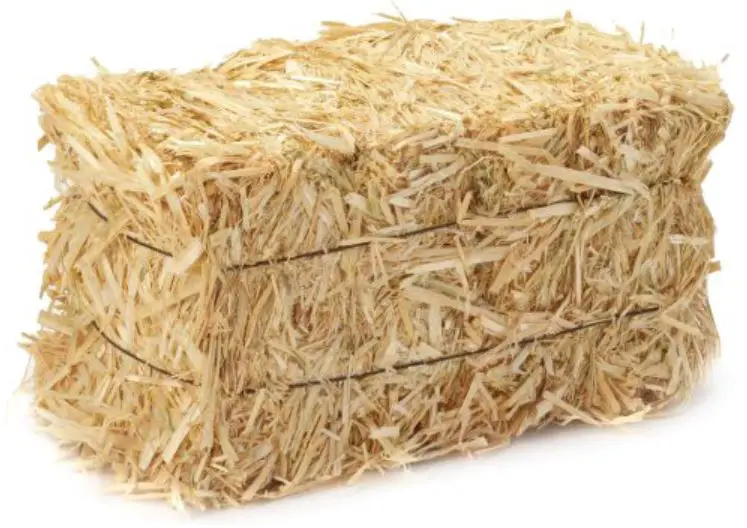
Farmers grow a range of cereal crops every year, such as barley, rice, rye, wheat and oats.
They harvest the crops – removing the grain and chaff, and are left with the dry stalks (around fifty percent of the yield is made up of leftover stems).
Farmers are resourceful folk, so it’s no surprise to learn they don’t consign the remnants to the bin.
Instead, they are bundled up, closely pressed together and formed into straw bales. These are held together by string or wire and come in a variety of shapes and sizes.
Straw Can Be Used As Comfy Bedding For Animals
Straw works well as comfy bedding for farm animals such as cows and horses.
Hay would prove to be an expensive alternative.
Straw Is A Source Of Fuel
Agricultural byproducts such a straw can be used as fuel to produce heat – this is far better than burning woody biomass.
Straw Isn’t The Best Animal Feed – but It’s Not A Bad Mixer!
Straw is best described as low-quality animal feed.
However, it can be used providing grain, vitamins and minerals are added to boost the nutrient levels.
Straw Can Top Off A Cottage Nicely
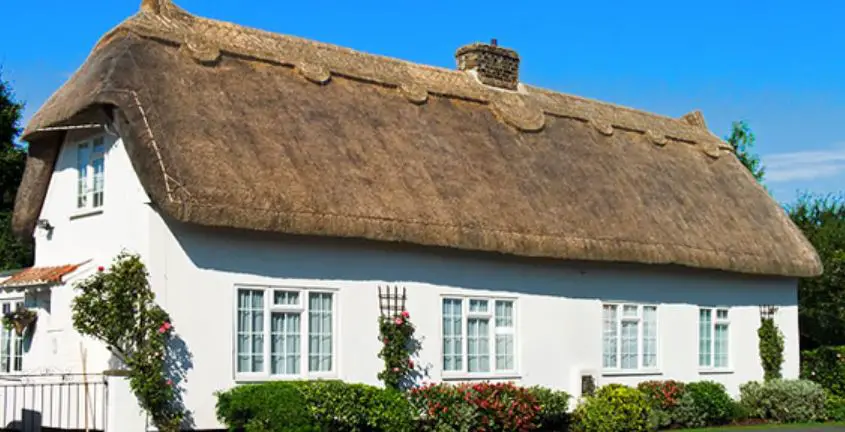
Dry vegetation such as water reed, rushes and straw can be used to thatch roofs.
However, this needs to be done by an expert who knows how to layer the thatch to ensure it remains watertight.
Straw Can Be Useful For Hobbies And Crafts
Straw can be used in a variety of crafts.
Get your creative hat on, get hold of some straw and try your hand at making straw dollies and baskets
The Lowdown On Hay
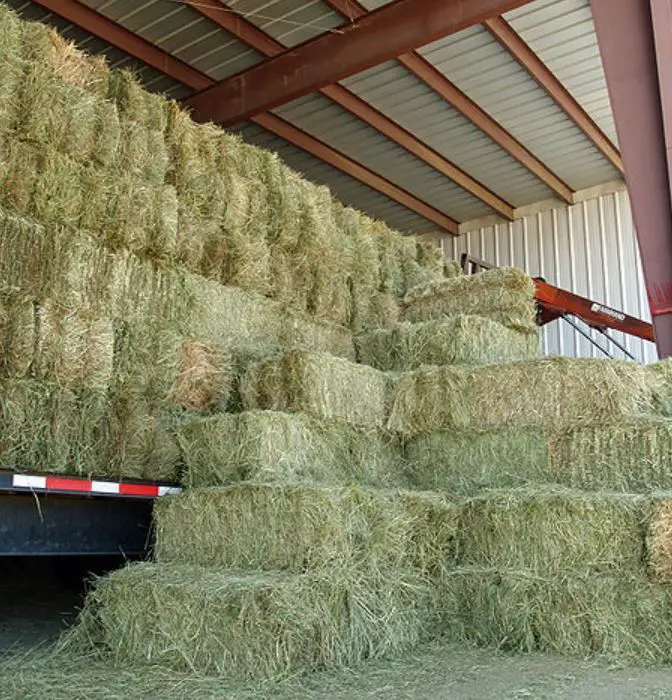
A tall field grass, hay is left to mature and then cut back to ground level.
The plant consists of a number of parts, including seed heads, stalks and leaves, and once cut, all are left to dry in the sun. The dry hay is then bundled together to form rectangular shaped bales.
Hay Is Quality Feed For Farm Animals

Farmers use hay to feed their animals as it’s rich in nutrients.
There are a variety of types available (we will look more at that later on).
Farms get through lots of hay each year, unsurprising when you learn that cows consume around 24 pounds of hay per day (that’s approximately 2.0% of their body weight).
Hay Is Also Used By Pet Owners
Hay is also used by pet owners to feed their beloved animals, such as rabbits and guinea pigs.
Owners like the fact that hay is linked to good health and dental hygiene.
Hay Feeds Zoo Animals Too!
Hay is also used at zoos to feed wild creatures such as giraffes and elephants.
Farms get through quite a bit, so you can imagine how much hay zoo’s use – especially when we tell you that, on average, an elephant can chomp up to 100 pounds of hay every day!
Hay Is A Stand In For Fresh Grass
Cattle enjoy grazing on fresh green grass, but there isn’t always enough to go round. When this happens (for example during a cold winter season) farmers can use hay as a nutritious alternative.
Hay Is An Expensive Alternative To Straw
Using hay for mulch and bedding can prove costly, and wasteful! Straw is perfectly adequate for a range of tasks – so save your hay for feeding time.
How To Tell The Difference Between Straw And Hay
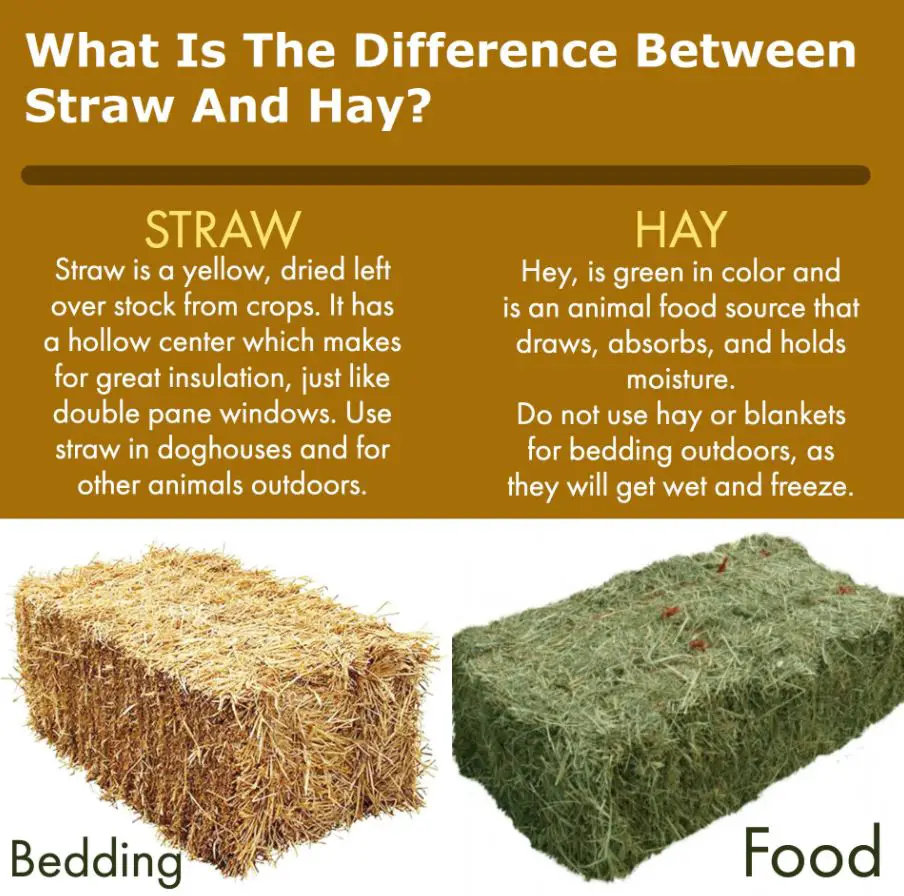
We know that straw is an agricultural by-product (leftover stalks).
It is gold and yellow in color, very dry, and has a much less noticeable smell than hay.
Straw isn’t a staple food for animals as it has little nutritional content, but it is good to use as bedding, mulch etc.
Hay is different, it is the primary product – grown to be used as animal feed. Hay is usually gold in color with a green hue, it also has a sweet smell.
Wet hay resembles grass, but once cut it is left to dry and then bundled. From there it is offered as dinner in zoos, farms and homes.
There are different species of hay, including Timothy, Oat, Orchard, Meadow and Alfalfa.
Some contain herbs too, and the taste and nutritional value can vary depending on the type.
Alfalfa hay is softer than some of its counterparts, such as Timothy, and features small clover-shaped leaves, stems, and little flowers.
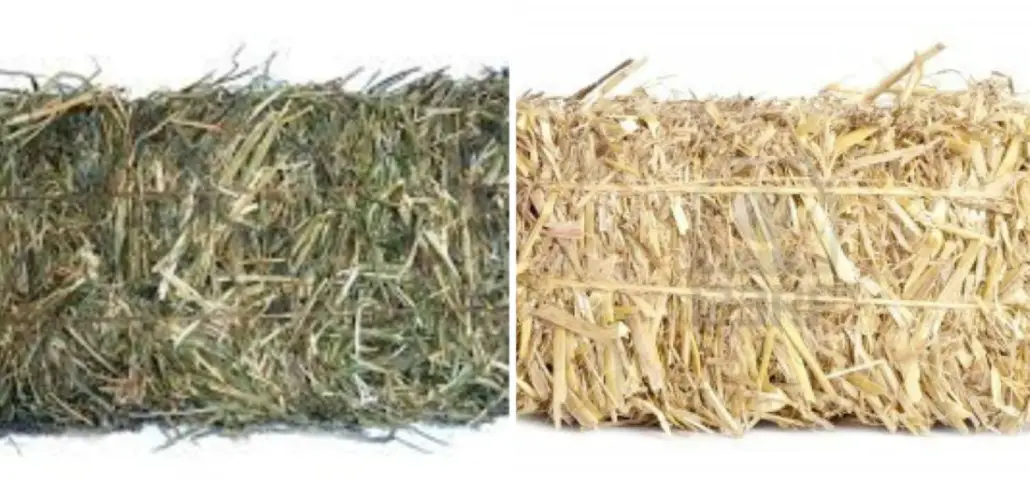
Alfalfa routinely given to younger animals and those who need a boost, as it is rich in protein, energy, calcium and nutrients.
Timothy hay is commonly used as cattle and horse feed. Its high in fiber, low in protein, and provides plenty of energy. It’s also very easy to digest.
Oat hay is thought of as good for foraging cattle, sheep and horses – it is rich and fiber and can be added to alfalfa too.
Orchard is a green, soft hay with a fruity smell – it seems to prove popular, and meadow hay is a mix of native soft pasture grasses.
Meadow features leaves and wild flowers such as daisies.
Check out this YouTube clip direct from the hay field, it will hopefully give you more of an insight into the hay harvest.
How Do Hay And Straw Compare On Price?
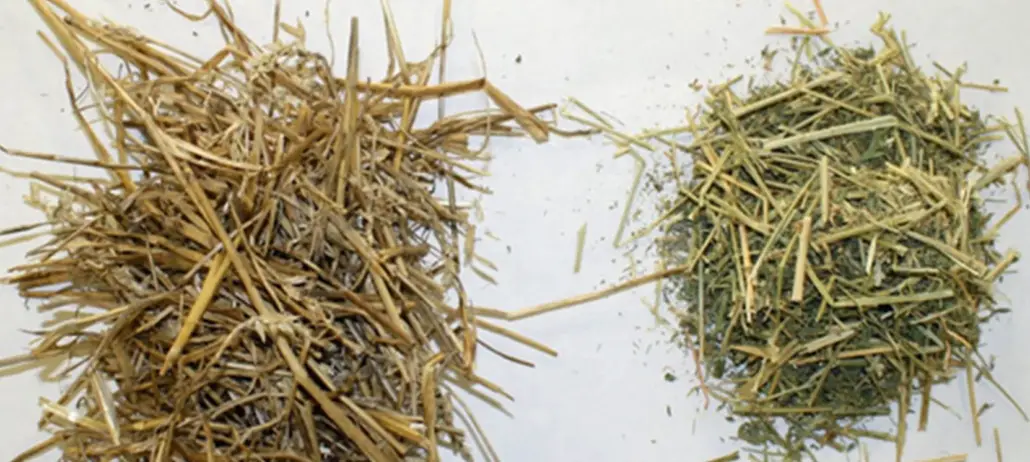
Straw is typically cheaper than hay, which makes sense – straw is a by-product.
It’s not used as a main feed for animals, but typically as bedding or mulch.
Hay is a primary product, grown specifically for its purpose – providing nutritional feed to animals.
That said, in certain areas, such as Nova Scotia, Canada, straw is pricier.
The climate doesn’t always lend itself well to cereal crop production, so straw can be in short supply.
As for hay, market prices fluctuate depending on weather conditions, where you live, the time of year and how much hay is readily available.
The market has been fairly stable over recent times, in comparison to the highs of 2014 and lows of 2016.
Which Type Is Most Popular?
The popularity of hay and straw is directly related to why people need it.
If you are looking to purchase feed for your animals you should take some time to peruse the different varieties of hay.
If you’re in the market for a soft bed or need some mulch for your garden, you will need to buy straw.
Which Is Best For Building?

There’s a definitive answer to this one – straw bales are for building; hay bales are for animal food.
Straw bales can be used in a number of ways, and have been used in construction from the 19th century.
Bales can be used to cram a timber frame, or they can be used as load bearers.
Which Is Best For Insulation?
Straw stands out as a super insulator. Not only is it inexpensive, it also has really good thermal properties. You can use straw to insulate both domestic buildings (infil timber frames) and farm buildings such as barns (a layer of straw on the floor).
Which Is Better For The Garden And Grass?
Straw is often used to cover planted grass seed. It’s affordable, but do opt for straw that’s relatively seed-free otherwise you might find weeds bursting through your turf!
Which Is Better Bedding For Animals?
Straw is dried out thoroughly prior to using, so it typically attracts no moisture and doesn’t go moldy.
Hay can still have a level of moisture running through it.
Which Is Better For Compost?
Straw can be composted but you do need to make sure that it isn’t contaminated by anything else.
Make sure your compost doesn’t become too dry by adding green produce to the mix too.
Hay, with its high levels of potassium and carbon, can also be composted.
Ideally, you should break it down first and then mix in some greenery to speed up decomposition.
Straw Vs Hay For Chickens?
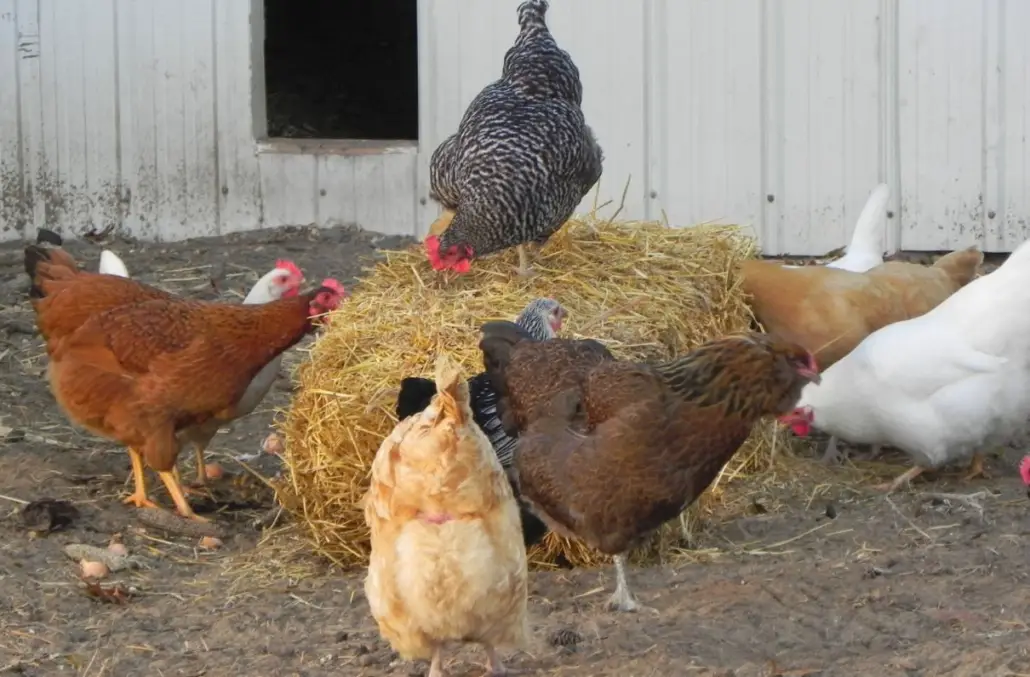
Straw is affordable and as it’s so dry it’s less likely to go moldy. Therefore, it’s perfect for chicken coops and nesting boxes.
Straw is also hollow, and this means it offers a nice springy base for delicate eggs.
The hollow inner also allows the straw to lock in warmth – so your chickens will enjoy a cozy home. Add extra straw bales for an even thicker layer of insulation.
Which Is Better For Horses?
Straw is good as a soft and practical covering for the stable floor, but hay provides the food for our equine companions.
Don’t be surprised if you horse takes a fancy to a few strands of straw – horses are partial to trying it!
Straw is fibrous so it will aid digestion, but it doesn’t have any nutritional value, so won’t do as a main course.
Can Cows Survive On Hay Alone?
You will often see a herd of cows ambling around a lush green field, happily chomping.
However, during winter the land becomes less productive and cows may need to look elsewhere for their sustenance.
When pasture land is scarce farmers turn to hay to feed their livestock. Cows tend to go for one of three types – cereal grain, legume or grass.
Straw Vs Hay Mulch
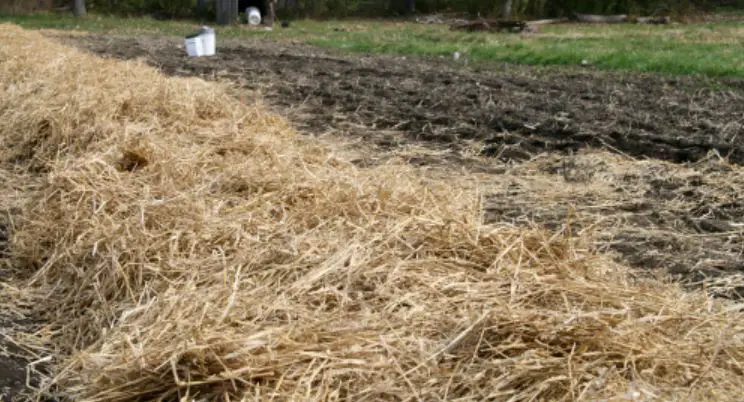
Mulch helps you to rid weeds from the garden, can be used to define pathways, and also acts as a temperature regulator.
It cools and moistens the soil during warmer months, and keeps it toasty during the colder season.
Straw and hay can both work as mulch. Hay is easy to get hold of, but it’s worth keeping in mind that it can be moist – and if you live in a damp climate it may attract garden pests such as slugs and snails.
Straw is lighter and retains an attractive golden hue when placed on the garden. The top of it will stay quite dry, but underneath the straw will start to break down.
As it’s lighter and fluffier than hay, it will take more time for the goodness to filter down through the soil. However, straw also retains warmth – so it will keep your borders and plants nice and snug.
Hay Vs Wheat Straw, Pea Straw And Pine Straw
As we’ve discovered, hay is grown as a nutritional feed for animals. So, how does it compare to wheat straw, pea straw and pine straw?
Wheat straw is often used as a building material, and dates back to ancient Egyptian times (where it was used to bind together bricks of clay).
Wheat straw has continued to be used to construct and insulate houses, and it has gained a reputation for being ecologically friendly.
Pea straw adds a great deal of nutrients and nitrogen to soil, it retains moisture and helps to keep the soil healthy for crops.
As the name suggest, pine straw is made up of fresh needles that fall from pine trees. Pine straw isn’t as heavy as bark mulch, it takes longer to break down and provides plenty of nutrients.
Straw Bale Vs Hay Bale
Take care not to pick up straw bales instead of hay bales! Both are often packed the same way and look alike.
Garden centers have been known to sell hay as straw, and unless you’re a farmer you might not spot the error!
If in doubt ask – or refer to our comparison table.
Which Is Best For You? Straw Or Hay
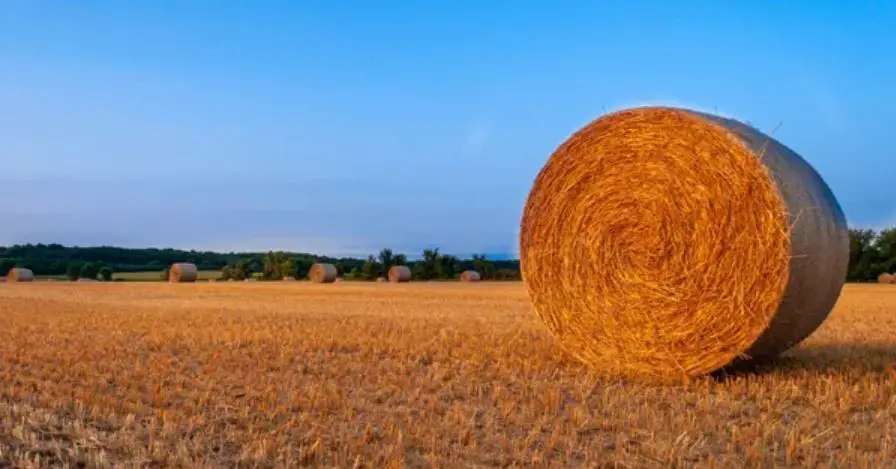
We know that straw is versatile and inexpensive, it can be used for a variety of purposes and is easy to get hold of.
Hay is also relatively accessible, but it has a very clear purpose – to feed animals.
It costs more, but if you need to feed cattle, rabbits or a large elephant it’s your best option! Think about what you need the straw or hay for, and go from there!


